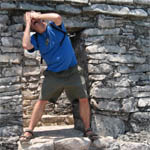When Howlin’ Wolf sang I’m built for comfort, I ain’t built for speed*, he probably wasn’t referring to yoga. Nonetheless, I suspect that similar thoughts have rung through the mind of many a yoga student sweating through a modern, fast-moving vinyasa class. And this might explain the growing enthusiasm for the slow, contemplative practices of Yin Yoga, as both alternative and complement to more vigorous styles.
In an hour and a half of yin practice, it’s not unusual to go through only a small handful of asanas—fewer even than might be experienced in the space of twenty breaths in a vigorous vinyasa sequence. The atmosphere is calm, quiet, eyes may be closed, and the teacher may take the time to tell a well-developed story, or provide lengthy explication of some aspect of yoga philosophy, before giving the instruction to switch sides.
Then, yin isn’t exactly lazy-man’s yoga. While never speedy, it’s not always comfortable to hold even the gentlest of poses for five minutes. In fact, it can be quite the opposite, as Bernie Clark points out repeatedly in The Complete Guide to Yin Yoga, emphasizing the importance of stress. Yin, as he describes it, is to a great extent about going into uncomfortable places is a slow and gentle fashion, and moving, thereby, into healing and freedom.
Of course, any time a book has a title with the word “complete” in it, the discerning reader has reason to be dubious. Any subject worthy of a book should be far too rich and multifaceted for its completeness to be encompassed within anything so finite as the covers of a trade paperback. And certainly, The Complete Guide to Yin Yoga is ultimately, more a doorway into its subject, a finger pointing to the yin moon**, than the last word. That’s not to say, however, that, having read it cover-to-cover, as any self-respecting book reviewer should feel duty-bound to do, I’m not utterly bowled over and overwhelmed by its depth and breadth.
The Complete Guide is encyclopedic, its early sections providing both in-depth descriptions of yin asanas and an array of sequences, thus serving as a very practical guide for home practice. A particularly useful aspect of this portion of the book is that it makes clear the similarities and differences between yin poses and similar, or, in many cases, seemingly identical, “yang” poses, which can be confusing to those experienced in more than once school of yoga (particularly those who, like me, have been known to take somewhat of a smorgasbord approach). In latter sections, we’re given extensive introductions to an incredibly wide range of paradigms that make up the complex root system of this peculiar discipline—Western, Indian, and Chinese, traditional and modern—providing a variety of lenses through which to understood its workings. This, not surprisingly, is where things gets really dense.
The book includes lots of footnotes**** pointing to sources that go into greater depth—as well as sources that throw the claims of certain modalities into question, revealing a striking even-handedness in offering an entrancing display of possibilities. Some might be bothered by such an unwillingness to simply lay out what is correct and what is incorrect—including identifying significant points with particular teachers, rather than emphasizing their timelessness, as yoga books are often wont to do—but The Complete Guide to Yin Yoga seems to have room for it all, and for all yogis—from those who put their faith in the ancient wisdom of the east to those who prefer to stay grounded in the modern, scientific west, while emphasizing sometimes surprising points of agreement between the two.
As such, it’s a treasure trove for anyone with a serious interest, and perhaps a bit of experience, in yin yoga. For those brand new to yin, or to yoga and general, however, I suspect it may seem a bit much. Early chapters assume knowledge of the basics, and even some not-so-basics (I learned about the ida, pingali, and sushumna back in teacher training, but must confess to not remembering which was which). In later chapters, much that’s mentioned early on is discussed in depth, which at times makes the book feel somewhat backwards. But, as noted above, this really isn’t a book most of us would want to read from front to back. It will, however, be an incredibly valuable one to have and keep as a companion to a yin practice.
Notably, except for a few brief mentions of yoga being used to gain liberation and enlightenment, this book deals almost exclusively with its more earthly benefits—or, as Bernie puts it “physical, emotional, and emotional health and well-being.” Patanjali is mentioned only briefly, and the Bhagavad Gita not at all. For some yogis such neglect of the deeper, spiritual essence of yoga may cause intense fluctuations of the mind matter. And, in reading so much about nadis and chi, such may afflict the aggressively modern and scientific-minded, as well. For both, I suggest calming down with some yin yoga.
* Written by Willie Dixon (who also, by the way, wrote half the songs Led Zeppelin claimed credit for).
** Yin enthusiasts—including Bernie Clark—have a noted weakness for puns on the word “yin.” I will be resisting such a tendency, and ask that those leaving comments do the same. Anyone engaging in such cheap wordplay will be subject to the harshest of punishment***.
*** Sorry…
**** Notably, the good jokes are mostly in the footnotes, too…really, so I recommend reading them even if you’re not the scholarly kind of reader who generally reads footnotes (then, if that’s the case, you’re probably not reading this, either; D’oh!). I particularly liked the one where he gave translated “no pain no gain” into Sanskrit as bullshitihi!






Read 4 comments and reply